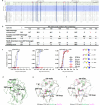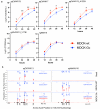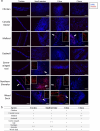Neu5Gc binding loss of subtype H7 influenza A virus facilitates adaptation to gallinaceous poultry following transmission from waterbirds
- PMID: 39225467
- PMCID: PMC11494897
- DOI: 10.1128/jvi.00119-24
Neu5Gc binding loss of subtype H7 influenza A virus facilitates adaptation to gallinaceous poultry following transmission from waterbirds
Abstract
Between 2013 and 2018, the novel A/Anhui/1/2013 (AH/13)-lineage H7N9 virus caused at least five waves of outbreaks in humans, totaling 1,567 confirmed human cases in China. Surveillance data indicated a disproportionate distribution of poultry infected with this AH/13-lineage virus, and laboratory experiments demonstrated that this virus can efficiently spread among chickens but not among Pekin ducks. The underlying mechanism of this selective transmission remains unclear. In this study, we demonstrated the absence of Neu5Gc expression in chickens across all respiratory and gastrointestinal tissues. However, Neu5Gc expression varied among different duck species and even within the tissues of the same species. The AH/13-lineage viruses exclusively bind to acetylneuraminic acid (Neu5Ac), in contrast to wild waterbird H7 viruses that bind both Neu5Ac and N-glycolylneuraminic acid (Neu5Gc). The level of Neu5Gc expression influences H7 virus replication and facilitates adaptive mutations in these viruses. In summary, our findings highlight the critical role of Neu5Gc in affecting the host range and interspecies transmission dynamics of H7 viruses among avian species.IMPORTANCEMigratory waterfowl, gulls, and shorebirds are natural reservoirs for influenza A viruses (IAVs) that can occasionally spill over to domestic poultry, and ultimately humans. This study showed wild-type H7 IAVs from waterbirds initially bind to glycan receptors terminated with N-acetylneuraminic acid (Neu5Ac) or N-glycolylneuraminic acid (Neu5Gc). However, after enzootic transmission in chickens, the viruses exclusively bind to Neu5Ac. The absence of Neu5Gc expression in gallinaceous poultry, particularly chickens, exerts selective pressure, shaping IAV populations, and promoting the acquisition of adaptive amino acid substitutions in the hemagglutinin protein. This results in the loss of Neu5Gc binding and an increase in virus transmissibility in gallinaceous poultry, particularly chickens. Consequently, the transmission capability of these poultry-adapted H7 IAVs in wild water birds decreases. Timely intervention, such as stamping out, may help reduce virus adaptation to domestic chicken populations and lower the risk of enzootic outbreaks, including those caused by IAVs exhibiting high pathogenicity.
Keywords: H7; H7N9; N-glycolylneuraminic acid; acetylneuraminic acid; duck; influenza A virus; receptor binding; spread; transmission; virus-host interactions.
Conflict of interest statement
The authors declare no conflict of interest.
Figures





Update of
-
Neu5Gc binding loss of subtype H7 influenza A virus facilitates adaptation to gallinaceous poultry following transmission from waterbirds but restricts spillback.bioRxiv [Preprint]. 2024 Jan 3:2024.01.02.573990. doi: 10.1101/2024.01.02.573990. bioRxiv. 2024. Update in: J Virol. 2024 Oct 22;98(10):e0011924. doi: 10.1128/jvi.00119-24. PMID: 38260375 Free PMC article. Updated. Preprint.
References
-
- Xiang N, Li X, Ren R, Wang D, Zhou S, Greene CM, Song Y, Zhou L, Yang L, Davis CT, et al. . 2016. Assessing change in avian influenza A(H7N9) virus infections during the fourth epidemic - China, September 2015-August 2016. MMWR Morb Mortal Wkly Rep 65:1390–1394. doi:10.15585/mmwr.mm6549a2 - DOI - PubMed
-
- Chen Y, Liang W, Yang S, Wu N, Gao H, Sheng J, Yao H, Wo J, Fang Q, Cui D, et al. . 2013. Human infections with the emerging avian influenza A H7N9 virus from wet market poultry: clinical analysis and characterisation of viral genome. Lancet 381:1916–1925. doi:10.1016/S0140-6736(13)60903-4 - DOI - PMC - PubMed
MeSH terms
Substances
Grants and funding
LinkOut - more resources
Full Text Sources
Medical

